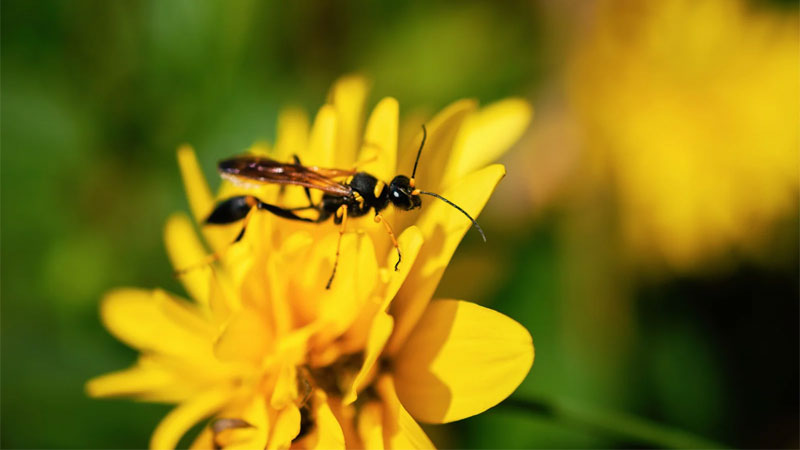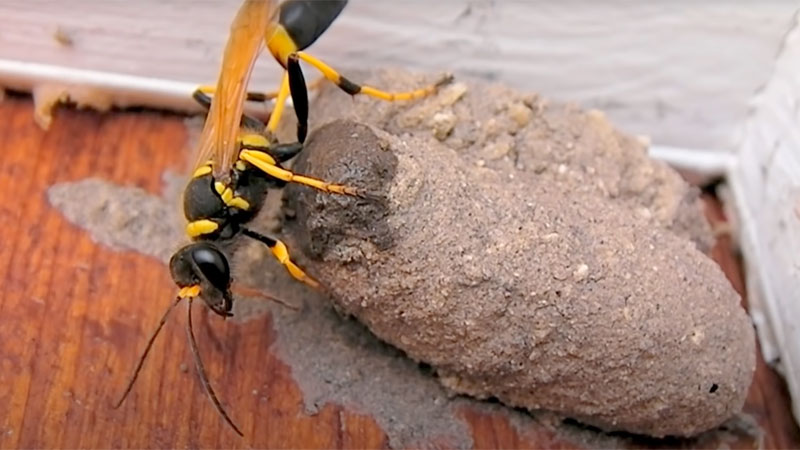Have you ever gone outside and noticed a strange mud structure on the side of your home or shed? These nests can be quite attractive or rather unsightly, depending on the species that made it, but they all contain critters that look very similar to wasps.
That’s because they’re mud dauber nests.
There’s a lot to know about these insects, some of which might surprise you. And if you still want to get rid of mud daubers, we’ll show you several ways to safely remove them from your home and property.
Getting to Know Mud Daubers
Mud daubers (AKA mud wasps) can be scary when you see one, but their looks can be misleading. In fact, mud daubers are considered beneficial insects. Let’s take a closer look (from a safe distance) at these critters, what they do, and whether we should be worried about them.
Mud Dauber vs Wasp
First of all, it should be noted that mud daubers actually ARE wasps from two different families.
They can be found throughout North America and tend to be diurnal. They generally come out in warm weather to collect mud from puddles. At around one inch long, daubers have narrow waists and tend to be either black and yellow or a metallic dark blue to black.
Nesting Habits
Mud daubers tend to be solitary and are usually placed into three categories based in part on their nest designs:
- Organ pipe mud daubers (Crabronidae family) create long mud tubes that resemble the pipes of a pipe organ that can be either horizontal or vertical and are found attached to bridges, caves, and cliffs.
- Black and yellow mud daubers (Sphecidae family) have round nests filled with long, cylindrical mud tubes that are usually attached to cracks, corners, and crevices.
- Metallic-blue mud daubers (also Sphecidae family) are sort of the odd one out, as they claim the nests of other mud daubers, using water to modify them for personal use. The blue mud wasp (Chalybion californicum) is especially famous as a spider killer.
Dauber Nest Function
While it might look like these wasps are building colonies, the tubes actually contain multiple cells in which paralyzed prey is placed. The female mud dauber lays a single egg on each of its prey and the larvae eat the host bug alive.
Because daubers are solitary wasps, they’re known to build their nests in parts of human structures that rarely see traffic, such as attics, barns, and sheds. It’s extremely rare for them to build a nest in major living areas or near frequently-used entrances.
Mud dauber wasp nests can be quite striking to look at, especially those of the organ pipe daubers. However, these nests are often a far greater pest than the daubers themselves. The nests can clog equipment and short out circuitry. Daubers have even been blamed for airline incidents!
Potter Wasps: The Other Mud Architect
It should also be noted that another group of wasps, the potter wasps, also tend to make mud nests. They have many of the same habits as mud daubers. The key difference is that potter nests literally resemble clay pottery.

Another issue is that the mud daubers only use the nests for reproduction. Defense isn’t something they think about, especially since they only live for a year. This can lead to other wasp species claiming the nests for their own.
If you see more than one wasp around a mud dauber nest, this is likely what has happened.
Mud Dauber Diet
Mud daubers and other wasps are omnivores. The typical dauber diet tends to make them quite beneficial to gardeners. Insects, and flower nectar not only give them food, but makes the mud dauber a combination of natural predator and pollinator for many plants.
Even more importantly, they tend to prefer spiders for their egg hosts and are particularly fond of black widow spiders. There’s even a species that specifically targets cicadas for their egg hosts.
On the flip side, mud daubers are a popular snack for insectivore birds. Keeping them around may help attract various species of songbird you can enjoy. It’s a win-win situation (for you, at least)!
Do Mud Daubers Pollinate?
While mud daubers are considered pollinators, they don’t pay much attention to pollen. Instead, they’re more likely to pollinate nectar-bearing plants normally dependent upon butterflies and hummingbirds.
However, they can also end up carrying pollen between flowers while hunting for insects. This makes them a valuable ally for gardens in locations that are less likely to get major pollinators.
Are Mud Daubers Aggressive?
This is a common misconception among most wasp and bee species. The simple truth is that mud daubers are more interested in what they’re doing than they are in what you’re doing. As long as you leave a mud dauber alone, they’ll go about their business and forget you’re even there.
Do Mud Daubers Sting or Bite?
So what happens if you DO come into contact with a mud dauber? Will they attack? The answer is actually based on how threatened they are.
A mud dauber’s stinger is used primarily to paralyze spiders to be used as egg hosts. They prefer to not use their stinger outside of this purpose. In fact, if you destroy a mud dauber nest, the dauber will just go somewhere else. They’ll only strike if you try to destroy the nest while they’re still inside.
In fact, solitary wasps tend to be far less aggressive than social wasps such as yellow jackets as a whole.
Mud dauber stings are very mild compared to other stinging insects. Be warned, their venom can still trigger an allergic reaction in sensitive individuals. Furthermore, if you have a real fear of getting stung, don’t start swatting at a nearby mud dauber.
Getting Rid of Mud Daubers
It’s surprisingly easy to get rid of a mud dauber, and not much more difficult to keep them away. Just note that these insects are almost entirely beneficial, so you might want to let them hang around.
SHOULD You Get Rid of Mud Daubers?
Due to the fact that mud daubers are beneficial insects, it’s important to ask this question before you go after them. These little critters can do a lot of good and aren’t really pests – although their nests CAN be a problem.
The Dauber Quiz
Before deciding whether to kill, relocate, or coexist with any species of mud dauber, ask yourself the following:
- Is the nest in a place where it can interfere with electrical equipment or airflow?
- Is the nest somewhere a child or pet is likely to come into contact with it?
- Does your property have other wasp species present which might lay claim to the nest?
- Do you or a loved one have an allergy to bee and wasp stings?
- Do you have a garden that doesn’t attract enough pollinators or has too many insect pests?
- Do you live in an area where black widows are common?*
The Results
Looking at the five questions, your answers will determine the best course of action.
if you answered yes to question 4: You’ll want the wasp completely off your property and extermination may be the easiest option.
A yes to questions 1, 2, and 3: Removing the nest itself may be the easiest option and the mud dauber will simply relocate to another part of the property or leave the property altogether.
For questions 5 and 6: A yes means you should seriously consider allowing the mud dauber to remain where it is (unless, of course, you also answered yes to other questions).
Meanwhile, the northern black widow (Latrodectus variolus) is most common in the mid-Atlantic states into parts of Canada during the summer, and as far west as Wisconsin. Both species have become naturalized in Hawai’i.
Black widows aren’t always deadly (depending on the species), but they’re still quite nasty. Mud daubers can eliminate them before you even notice there’s a problem.
How to Remove a Mud Dauber Nest
Unless you’re severely allergic, the single best way to get rid of this type of wasp is to simply remove their homes. This is an incredibly easy task unless the nest is on a fragile surface such as stucco.
Scraping
To remove, simply wait until the dauber isn’t home and use a paint scraper or putty knife to separate the nest from the surface it’s attached to. Mud daubers often “close the door” when at home, but this isn’t a foolproof method of telling whether they’re home or not, and organ pipe species have far too many doors to begin with.
Be sure to wear some protective gloves just in case, and don’t worry if you see some spiders falling out – they’re completely paralyzed and you can simply put them out of their misery with your shoe.
Melting
But what about stucco and other surfaces that can be easily damaged by scraping? For these, a high pressure garden hose can be enough. Remember, these are daub nests, meaning they’ll melt if you get them wet enough (humans make daub with straw and other additives to reduce the risk of erosion). Just spray them and they’ll slowly soften to the point you can remove them without harming the surface.
In both cases, you can simply wash away any remaining mud residue with a spray bottle and cloth. You can discard the remains of the nest in the trash.
But wait! There’s one more removal option for those with a steady hand: nest relocation!
Nest Relocation
For this method, you’ll want to act at night and definitely wear some protective gear. You may also want to carefully plug the holes with cotton balls while you work.
Using a bowl of water to keep the knife wet, gently work the nest away from the wall, working your way around. Using a dropper to add water directly to the seams and giving it a moment to soften the mud will also help.
When you finally separate the nest from the surface it was attached to, you can relocate the entire nest to another spot where it won’t be in the way. Be gentle so you won’t damage the nest or agitate the dauber inside. Once the nest is in its new home, slowly remove the cotton doorstops so the dauber can get in and out again.
Killing Mud Daubers
Again, this tends to be an extreme and unnecessary response, but may be the best option for households that have a severe bee and wasp allergy. You can use several basic methods, all of which are quick and effective since you only have one wasp to deal with:
- Wasp freeze sprays are messy but highly effective. They’re best used at night by spraying directly into the nest’s openings.
- Insecticidal sprays (like Spectracide) will also work wonders but can leave behind residue.
- Since daubers are solitary critters, they can be killed with a flyswatter.
- Inaccessible nests can be sprinkled with food-grade diatomaceous earth (DE) which will slowly kill any insect unfortunate enough to be lacerated by its sharp surfaces.
Preventing Mud Daubers
Keeping daubers away from your property is actually quite easy. Here are some quick tricks to keep your property dauber-free:
- Mud daubers seek out places where there are prey (especially spiders), so one of the best methods you can use is to simply eliminate any spiders or webbing around the property.
- On the flip side, consider having bird feeders that cater to insectivores such as orioles and starlings. The more birds hanging out on the property, the more unattractive it will be for a mud dauber.
- You will also want to seal any possible entry points, including cracks or crevasses on external structures such as decks.
- Peppermint or citrus oil sprays will repel daubers and many other pests.
- Vinegar also repels a number of pests, but be careful using it around plans.
- For reasons not entirely known, mud daubers tend to avoid the color blue. A popular theory is that they get confused and think it’s open sky. This mysterious fact is why the color “haint blue” is so popular in the South.
- Plant insect-repelling herbs in your garden. Alliums, peppermint, and other strong-scented plants help keep a lot of pests away.
- Forbid the possession or use of Bingo equipment on your property.
Some Final Thoughts
Wasps tend to have a bad reputation, and mud daubers are among the least aggressive wasps out there. Adult mud daubers built their nests from mud, often making works of art. However, the nests themselves tend to be the real problem.
The benefits of daubers far outweigh the problems (unless you’re allergic to wasp venom). They eliminate unwanted insects and spiders while pollinating your garden. But if you do need to get rid of them, they’ll often comply without a fuss.
Of the many insects we cover on this site, daubers are one bug you’ll likely never need to hire a pest control service to deal with. Just be sure to wear gloves when evicting a dauber.
- How to Get Rid of Hawks - March 8, 2024
- How to Get Rid of Pill Bugs (Rolly Pollies) - March 1, 2024
- How to Get Rid of Groundhogs (Woodchucks) - February 5, 2024







